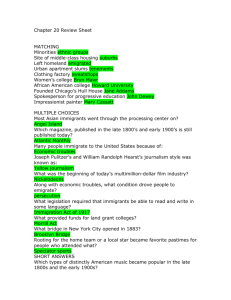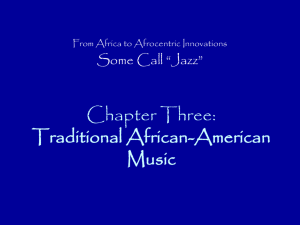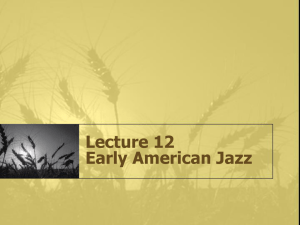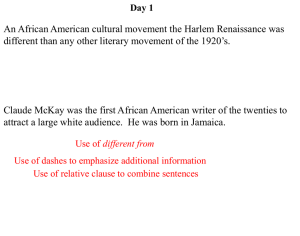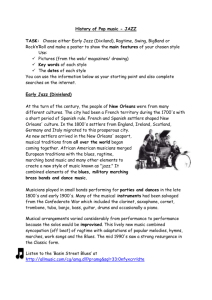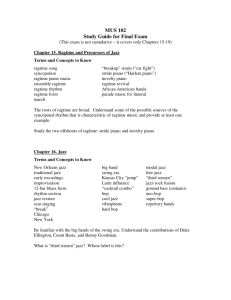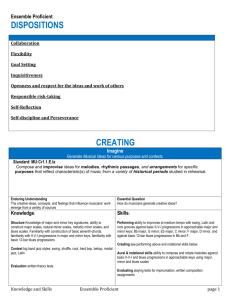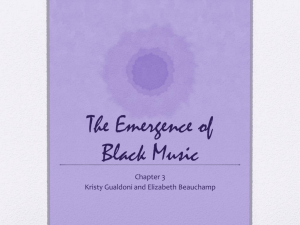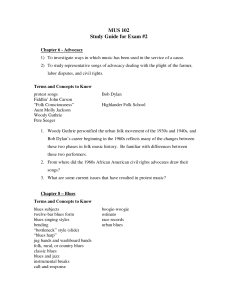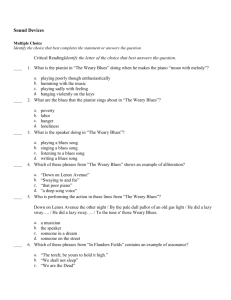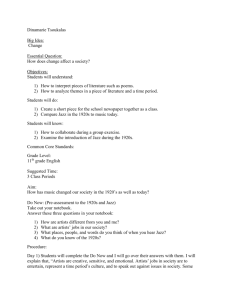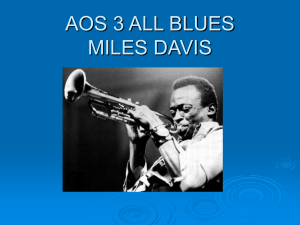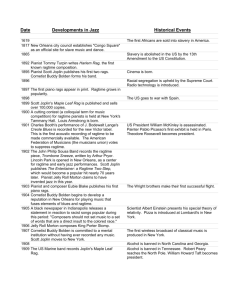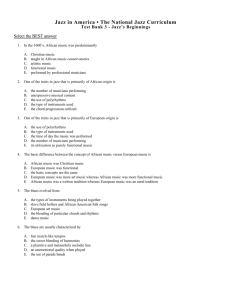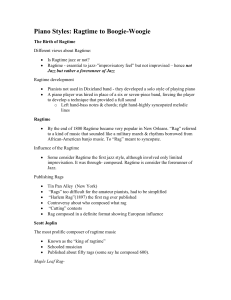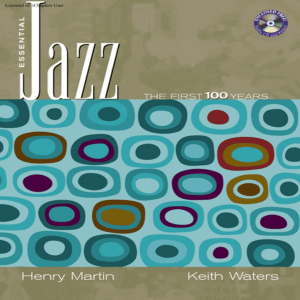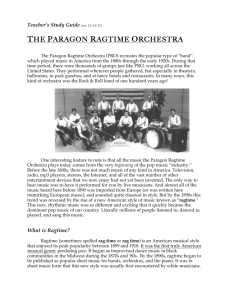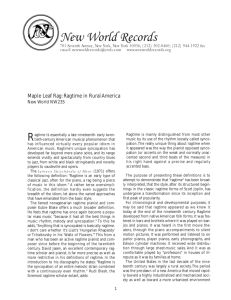1890 – 1920, Blues The origin of the term of was most likely derived
advertisement
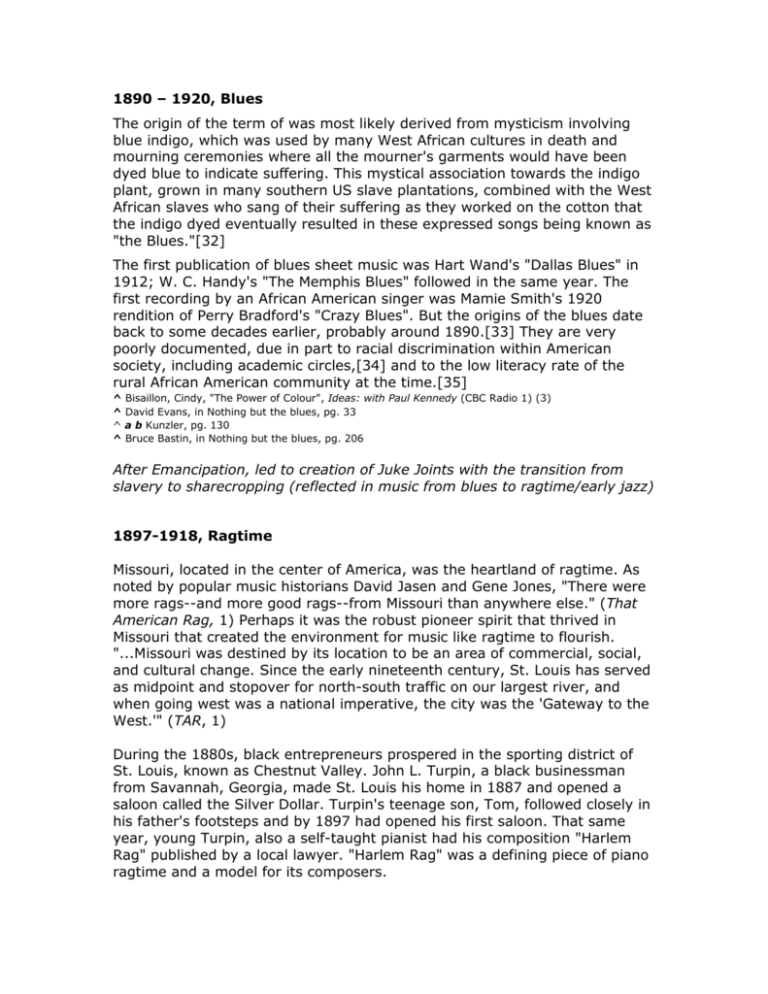
1890 – 1920, Blues The origin of the term of was most likely derived from mysticism involving blue indigo, which was used by many West African cultures in death and mourning ceremonies where all the mourner's garments would have been dyed blue to indicate suffering. This mystical association towards the indigo plant, grown in many southern US slave plantations, combined with the West African slaves who sang of their suffering as they worked on the cotton that the indigo dyed eventually resulted in these expressed songs being known as "the Blues."[32] The first publication of blues sheet music was Hart Wand's "Dallas Blues" in 1912; W. C. Handy's "The Memphis Blues" followed in the same year. The first recording by an African American singer was Mamie Smith's 1920 rendition of Perry Bradford's "Crazy Blues". But the origins of the blues date back to some decades earlier, probably around 1890.[33] They are very poorly documented, due in part to racial discrimination within American society, including academic circles,[34] and to the low literacy rate of the rural African American community at the time.[35] ^ ^ ^ ^ Bisaillon, Cindy, "The Power of Colour", Ideas: with Paul Kennedy (CBC Radio 1) (3) David Evans, in Nothing but the blues, pg. 33 a b Kunzler, pg. 130 Bruce Bastin, in Nothing but the blues, pg. 206 After Emancipation, led to creation of Juke Joints with the transition from slavery to sharecropping (reflected in music from blues to ragtime/early jazz) 1897-1918, Ragtime Missouri, located in the center of America, was the heartland of ragtime. As noted by popular music historians David Jasen and Gene Jones, "There were more rags--and more good rags--from Missouri than anywhere else." (That American Rag, 1) Perhaps it was the robust pioneer spirit that thrived in Missouri that created the environment for music like ragtime to flourish. "...Missouri was destined by its location to be an area of commercial, social, and cultural change. Since the early nineteenth century, St. Louis has served as midpoint and stopover for north-south traffic on our largest river, and when going west was a national imperative, the city was the 'Gateway to the West.'" (TAR, 1) During the 1880s, black entrepreneurs prospered in the sporting district of St. Louis, known as Chestnut Valley. John L. Turpin, a black businessman from Savannah, Georgia, made St. Louis his home in 1887 and opened a saloon called the Silver Dollar. Turpin's teenage son, Tom, followed closely in his father's footsteps and by 1897 had opened his first saloon. That same year, young Turpin, also a self-taught pianist had his composition "Harlem Rag" published by a local lawyer. "Harlem Rag" was a defining piece of piano ragtime and a model for its composers. By 1900 Tom Turpin had acquired sufficient capital to open a new saloon, the Rosebud. His two young protégés, Joe Jordan and Louis Chauvin, frequented the establishment. With the constant rollicking, buoyant sound of ragtime, Turpin, Jordan, Chauvin, and many other enthusiastic proponents of the new music, made the Rosebud and St. Louis the capital of ragtime. The regular flow of traffic through St. Louis and the rest of the state created a demand for accommodations and amenities for travelers. "As Missouri gentrified it became a state where a piano player could make a good living." (TAR, 2) As their salaries usually were nominal, the nomadic pianists made their best money from tips provided by the patrons of the many saloons that employed them. Ragtime popularity grew with compositions of Scott Joplin (The Entertainer, Maple Leaf Rag) and Jelly Roll Morton. Ragtime and Jazz began to overlap, with jazz surpassing ragtime in mainstream popularity in the early 1920’s. 1920’s, Jazz Age Jazz facilitated the mesh of African American traditions and ideals with the white middle class society. The jazz age came about when prohibition in the United States banned the sale of alcoholic drinks resulting in illicit, but lively, Speakeasies, where jazz flourished. Speakeasy illegally sells alcohol. Often referred to the as the Roaring 20’s – prosperity was widespread – everything seemed feasible through modern technology. New technologies, especially automobiles, moving pictures and radio proliferated ‘modernity’ to a large part of the population. Formal decorative frills were shed in favor of practicality in both daily life and architecture. At the same time, jazz and dancing rose in popularity, in opposition to the mood of the specter of World War I. Women’s suffrage at it peak and the entrance of the flapper women began to make a statement within society and the jazz age was not immune to these new ideas. With women now taking part in the work force after the end of the First World War there were many more possibilities for women in terms of social life and entertainment. Emergence of famous women musicians including Bessie Smith, not only a great singer but also an African American woman. Youth used the influence of jazz to rebel against the traditional culture of previous generations. This went hand in hand with fads like bold fashion statement (flappers) and new radio concerts, dance like the Charleston developed by African Americans suddenly became popular among younger demographics. 1930’s, Big Band The big band is a type of musical ensemble associated with jazz, a style of music, which became popular during the Swing Era from the early 1930’s until the late 1940’s. The Big Band was slow to take off because of The Great Depression, which closed nightclubs. This type of ensemble finally took off through radio with Benny Goodman and the emergence of the swing style with bandleaders like Count Basie, Duke Ellington, Benny Goodman, Artie Shaw and Woody Herman. Many bands toured the country in grueling one night stands to reach out to their fans. Traveling conditions and lodging were often difficult, in part due to segregation in most parts of the United States. At the end of 1930’s, big band played a major role in lifting morale during World War II. Many band members served in the military and toured with USA troupes at the front with bandleader Glenn Miller. 1940’s, Swing Era, rise of the vocalist, Bebop During the 1940’s, war production pulled us out of the Great Depression. Women often replaced men who had gone off to war. This was often the first time that these women had moved from working in the home to the workplace. Even after the men had returned and the women had to give up their jobs the returning men, they still felt a sense of independence that reflected in their lifestyles and taste in music. The men also returned with different as ideals, after having seen the rest of the world they were no longer satisfied with the family farm as the ideal. Also, blacks were more determined to attain equal status. At the beginning of the decade, the swing style of Big Bands dominated popular music. Eventually, many of the singers with the Big Bands struck out on their own, with the prominence given to the smooth voices of Bing Crosby, Frank Sinatra, Dinah Shore and Perry Como. Be-Bop and Rhythm and Blues grew out of the big band era toward the end of the decade. Although these were distinctly black sounds, epitomized by Charlie Parker, Dizzy Gillespie, Thelonious Monk, Billy Holiday, and Ella Fitzgerald. Bebop was a new style that came out of swing music, but strived to counter the popularization of swing with non-danceable music that demanded a more sophisticated listener.
